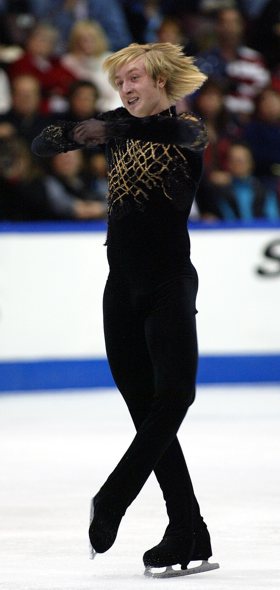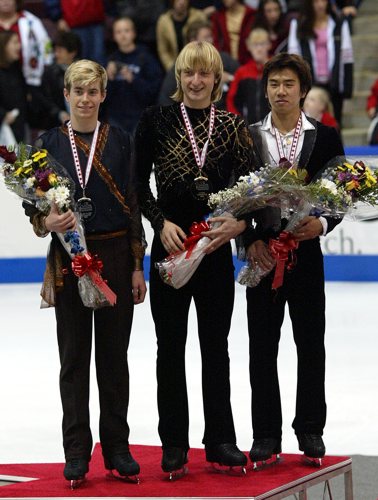Starting Order - Free Skating
-
Fedor Andreev
-
Ryan Jahnke
-
Stanick Jeannette
-
Stanislav Timichenko
-
Kevin Van Der Perren
-
Chengjiang Li
-
Takeshi Honda
-
Emanuel Sandhu
-
Evgeni Plushenko
-
Daisuke Takahashi
-
Jeffrey Buttle
|
Free Skating Placements
|
| Place |
Skater |
Country |
| 1 |
Evgeni Plushenko |
RUS |
| 2 |
Jeffrey Buttle |
CAN |
| 3 |
Kevin Van Der Perren |
BEL |
| 4 |
Takeshi Honda |
JPN |
| 5 |
Emanuel Sandhu |
CAN |
| 6 |
Ryan Jahnke |
USA |
| 7 |
Daisuke Takahashi |
JPN |
| 8 |
Chengjiang Li |
CHN |
| 9 |
Stanick Jeannette |
FRA |
| 10 |
Fedor Andreev |
CAN |
| 11 |
Stanislav Timichenko |
RUS |

|
Lackluster programs threatened to overwhelm the Hershey Arena during this
evening's men's free program, but two gems of performances - from Kevin van Der
Perren and Jeffrey Buttle - saved the night.
Meanwhile, two-time World champion Evgeni Plushenko added another notch to
his belt, winning his second Skate Canada and his first since 1998. The young
Russian, who led after the short, debuted his new free program, "Tribute to
Nijinski," an ode to the early twentieth century Russian ballet dancer. He
opened with a quadruple toe loop, then turned his second planned quad into a triple
toe loop. Although Plushenko reeled off five more triples in his program,
his only combination was a rather wobbly triple Salchow, single toe loop.
Choreographically, "Nijinsky" was a mixed bag. The skater opened the program
borrowing abstract arm movements and baroque poses from photos of Nijinski,
but did not carry the theme through to the second half of the routine. He
ended the competition with 233.65 points, setting a new "world record."
"It was ok for today, for my first competition," said Plushenko. "I planned
to do only one quad and one triple Axel." He added that he was still hampered
by an injury to his right knee (meniscus) and had suffered from a cold last
week.
Buttle, who placed second at the 2003 Canadian Nationals, had the performance
of the competition with his stirring "Samson and Delilah" program, choreographed by David Wilson. The 21 year-old opened with a solid triple flip, then
fell on his elusive quadruple toe loop but quickly recovered to land a triple
Axel, followed by a brilliant flying camel and another triple Axel, this time
completed in combination with a double toe loop.
He went on to land two more clean triples (he stepped out of his final jump,
a triple Lutz), but his jumps were truly secondary to his other elements: a
gorgeous Ina Bauer (immediately proceeding a triple flip); fully stretched out
inside spread eagle; change foot combination spin including a "pancake" sit
spin position. He earned 141 total points for his free program (vs. Plushenko's
152.40) and 209.63 overall.
"I felt comfortable out there. The audience was so warm, I fed on their energy. I've been practicing great all week," said Buttle, a chemical engineering
at University of Toronto. "The medal wasn't expected but I certainly appreciate it.
"Under the old system, it would have been much harder for me to move from fourth to second place," he continued. "That fact that code of points rewards
each element individually really helps me."
When asked if this could mark him taking center stage in Canada, Buttle replied, "Why not? I've worked hard and I deserve it."
Skating to "Warsaw Concerto," once again choreographed by Nikolai Morozov,
two-time World bronze medalist Takeshi Honda of Japan failed to repeat the
excitement he generated at last week's Skate America free skate. Honda opened with
an almost impossibly high quadruple toe loop, but lost control of the jump
and fell. He followed with a triple Salchow (he had intended to do a quad), and
a triple Axel, double toe loop combination, but fell again on another quad
toe attempt. Other elements included a beautiful triple Lutz out of footwork
and a slightly turned out triple flip.
"I was not very happy, because I missed all three quads, but overall it was
ok," said Honda, who took the bronze medal here with 207.78 points.
Canadian champion Emanuel Sandhu elected to keep last season's free program
for another year. He opened with a quadruple toe loop attempt, but fell hard,
and seemed to lose energy (and interest) as the program went on. His usual
crisp, exciting spins and footwork were slower than usual, and he landed only
three clean triple jumps. He ended the competition in fourth place, with 195.76
total points.
Skating to the theme from "Robin Hood," choreographed by his coach,
Morozov, Kevin van der Perren of Belgium - who sat dead last after the short program --
had the performance of his life. He opened with a solid triple Lutz, triple
toe loop combination (earning a base value of 10.6 and a GOE of 1.20) then
followed with a spectacular triple Salchow, triple toe loop, triple loop combination (base value of 14.60 and GOE of 1.40). Later in the program, he hit a
strong triple flip and another triple Lutz; he did not try a quad or triple Axel,
opting instead for two double Axels.
Van der Perren's success highlights another aspect of the new judging system
- clean, well done jumps will be rewarded. For many skaters, it may be best
to perform "within themselves" and include only those elements they have a
better-than-even chance of hitting.
"That was the best free program I ever had, for sure," said Van der Perren,
who earned 132.19 points for his free (the third highest total of the night)
and climbed from 11th to fifth place overall. "I can do the triple Axel, but I
am still breaking in new boots. I hope to do it in my next competition,
Lalique." (Van der Perren's previous boots broke down unexpectedly a few weeks
ago.)
American Ryan Jahnke redeemed himself after a disastrous free program at Skate America, hitting five triples and climbing from seventh place in the short
to sixth place overall. Japan's Daisuke Takahashi showed good musicality and
footwork in his "Paganini" free, although he had trouble with most of his jumps. He ended in seventh place.
Chengjiang Li had a disappointing outing; after hitting his second jump, a
quadruple Salchow, double toe loop combination, he seemed to lose stamina, and
landed only three more triples. He finished eighth. Frenchman Stannick Jeannette was once again a crowd favorite with his inventive
"Brazil" program, in which he dressed as a street-smart soccer player, but simply failed to land his
jumps and ended up ninth.
Stanislav Timchenko of Russia had an undistinguished outing to "Night on
Bald Mountain" and finished tenth. Though he finished eleventh (and last) Canada's Fedor Andreev illustrated an important point: he opened with three
combinations - a triple flip, triple toe loop; triple Axel, double toe loop; and
triple Lutz, double toe loop - the final combination did not count, because skaters
are only allowed to complete two combinations.
|
